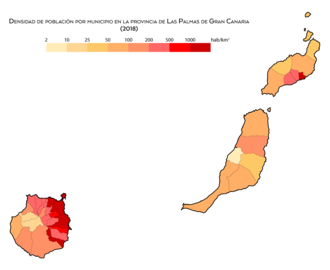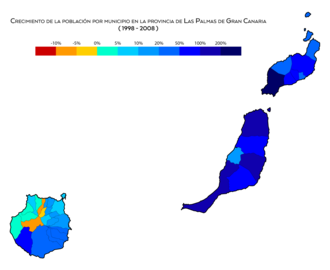Las Palmas Province
Las Palmas is a Spanish province that encompasses the eastern part of the autonomous community of the Canary Islands. The islands of Fuerteventura, Gran Canaria, Lanzarote and La Graciosa are attached to it, along with the uninhabited islets of Lobos, Alegranza, Montaña Clara, Roque del Este and Roque del Oeste. It has a surface area of 4,066 km², with 1,129,395 inhabitants (2022), being the most populous province in the Canary Islands and the thirteenth in Spain.
The capital of the province is the city of Las Palmas de Gran Canaria, on the island of Gran Canaria, the city with the largest population and population density in the Canary Islands, and the 9th in Spain by number of inhabitants. In addition, its metropolitan area occupies a population of more than 700,000 inhabitants, making it the largest in the Canary Islands. Las Palmas de Gran Canaria is also the capital of the autonomous community of the Canary Islands together with Santa Cruz de Tenerife.
History
The province arose in 1927 when the province of Canarias (with its capital in Santa Cruz de Tenerife) was divided into the provinces ofː Las Palmas and Santa Cruz de Tenerife.
The province received the name of its capital, but when the name of the city was changed years later to the current Las Palmas de Gran Canaria, the homonymy between province and capital was lost, since the province continued to be called Las Palmas to dry.
Toponymy
There is no common demonym for the inhabitants of the province, using proper demonyms for each island. Thus the inhabitants of Gran Canaria are called "grancanarios" and colloquially "canariones"; to those of Fuerteventura, "majoreros"; and those of Lanzarote, "lanzaroteños" or "conejeros". For their part, the inhabitants of La Graciosa are known as “gracioseros”.
The islands that make up the province of Las Palmas are commonly called "eastern islands", to differentiate them from the islands of the province of Santa Cruz de Tenerife, called "western islands" due to their geographical location to the west of this province. On occasions, the name "Canarian Islands" has also been used for the province of Las Palmas, although this name arises from the influence of the Catholic diocese of this province, called the Canariense Diocese or the Canariense-Rubicense Diocese. In this sense, the province of Santa Cruz de Tenerife for its part is called "Nivarienses islands", also by the name of its diocese.
Geography
Nature
The province of Las Palmas has a national park, Timanfaya in Lanzarote, as well as numerous parks and nature reserves. Such are the Inagua Nature Reserve, in Gran Canaria, or the Chinijo archipelago, among many others.
All the islands of this province have been declared Biosphere Reserves by UNESCO.
Some natural monuments of the province are the Jandía peninsula, each and every one of the islets (Alegranza, Clara mountain, Roque del Este, Roque del Oeste and Lobos island), the island of La Graciosa, the peninsula of La Isleta, Dedo de Dios, Roque Nublo, the beach and cliffs of Famara, Roque Bentayga, etc.
Administration and politics
Unlike most provinces in Spain, the province of Las Palmas (as well as Santa Cruz de Tenerife) lacks a common administrative body for the entire province. The powers normally held by the Provincial Councils are divided between the Government of the Canary Islands and the Island Councils. The Official Bulletin of the Province of Las Palmas is published by the Government of the Canary Islands.
Demographics
The population of the province of Las Palmas is 1,129,395 (INE 2022). By islands, the most inhabited is Gran Canaria with 855,521 inhabitants, followed by Lanzarote with 155,812 and Fuerteventura with 119,732.
If we focus on population density, it can be seen that the most populated area is the northwestern coast of the island of Gran Canaria, where the capital of the province is located, Las Palmas de Gran Canaria, with 381,223 inhabitants.
In terms of population growth, the island that has grown the most in the last 20 years is Fuerteventura, with 131.08%, going from 49,020 in 1998 to 113,275 in 2018. It is followed by the island of Lanzarote, with a growth of 75.82% and finally Gran Canaria with a growth of 18.26%.
The municipalities that benefited most from population growth are those located in Fuerteventura, followed by the south of Lanzarote and the southwest coast of Gran Canaria.
Territorial organization
| Municipality | Island | Population (2018) | Surface ('km2) | Density (hab/km2) |
|---|---|---|---|---|
| Agaete | Gran Canaria | 5573 | 45.5 | 122.48 |
| Agüimes | Gran Canaria | 31152 | 79.28 | 392,94 |
| Antigua | Fuerteventura | 11948 | 250.57 | 47.68 |
| Arrecife | Lanzarote | 61351 | 22,72 | 2700,31 |
| Artenara | Gran Canaria | 1090 | 66.7 | 16,34 |
| Arucas | Gran Canaria | 37691 | 33,01 | 1141.81 |
| Betancuria | Fuerteventura | 731 | 103.64 | 7.05 |
| Firgas | Gran Canaria | 7491 | 15,77 | 475.02 |
| Gáldar | Gran Canaria | 24209 | 61,59 | 393,07 |
| I would. | Lanzarote | 4969 | 106.59 | 46,62 |
| Ingenio | Gran Canaria | 30831 | 38.15 | 808,15 |
| Mogan | Gran Canaria | 19657 | 172.43 | 114,00 |
| Moya | Gran Canaria | 7728 | 31,87 | 242,49 |
| The Olive | Fuerteventura | 25884 | 356,13 | 72.68 |
| Bird | Fuerteventura | 20539 | 383,52 | 53,55 |
| Las Palmas de Gran Canaria | Gran Canaria | 378517 | 100.5 | 3766.34 |
| Puerto del Rosario | Fuerteventura | 39382 | 289,95 | 135.82 |
| San Bartolomé | Lanzarote | 18327 | 40,89 | 448.20 |
| San Bartolomé de Tirajana | Gran Canaria | 53588 | 333.13 | 160.86 |
| The Village of Saint Nicholas | Gran Canaria | 7608 | 123,58 | 61,56 |
| Santa Brígida | Gran Canaria | 18314 | 23,81 | 769.17 |
| Saint Lucia of Tirajana | Gran Canaria | 71863 | 61,56 | 1167.37 |
| Santa María de Guía de Gran Canaria | Gran Canaria | 13924 | 42,59 | 326.93 |
| Teguise | Lanzarote | 22122 | 263,98 | 83.80 |
| Tired | Gran Canaria | 1921 | 103.29 | 18,60 |
| Telde | Gran Canaria | 10242424 | 102.43 | 999.94 |
| Teror | Gran Canaria | 12449 | 25.7 | 484,40 |
| Tías | Lanzarote | 20006 | 64.61 | 309,64 |
| Tinajo | Lanzarote | 6119 | 135.28 | 45,23 |
| Tuineje | Fuerteventura | 14791 | 275,94 | 53,60 |
| Valsequillo de Gran Canaria | Gran Canaria | 9278 | 39.15 | 236,99 |
| Valleseco | Gran Canaria | 3784 | 22,11 | 171,14 |
| Vega de San Mateo | Gran Canaria | 7625 | 37,89 | 201,24 |
| Yaiza | Lanzarote | 16289 | 211,84 | 76.89 |
The province of Las Palmas is the 15th in Spain in which there is a higher percentage of inhabitants concentrated in its capital (34.13%, compared to 31.96% for the whole of Spain).
Contenido relacionado
Geography of Senegal
Transportation in Bolivia
Phoenicia



